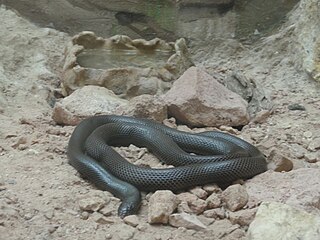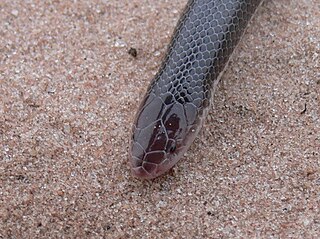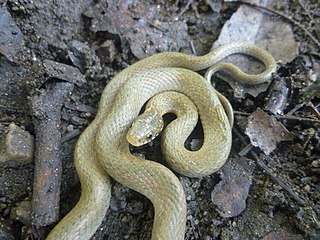
Atractaspis is a genus of venomous snakes in the family Lamprophiidae. The genus is endemic to Africa and the Middle East. The genus contains 15 species that are recognized by ITIS. Others recognize as many as 21 species. 23 are listed here.

Erythrolamprus cobella, commonly known as the mangrove snake, is a species of small semi-aquatic snake, which is endemic to South America.
Uropeltis myhendrae, commonly known as Mahendragiri earth snake or the Myhendra Mountain Uropeltis, is a species of snake in the family Uropeltidae. It is endemic to Western Ghats.

Hydrophis melanocephalus, commonly known as the slender-necked sea snake, is a species of venomous sea snake in the family Elapidae.

Atractaspis bibronii is a species of venomous snake in the family Atractaspididae. The species is endemic to Africa. No subspecies are currently recognized.

The Japanese keelback is a species of colubrid snake, which is endemic to Asia.
Atractaspis aterrima, commonly known as the slender burrowing asp or mole viper, is a species of fossorial, venomous snake in the family Atractaspididae. The specific epithet, aterrima, meaning "blackest", is the superlative form of the Latin adjective ater, meaning "black".
Atractaspis corpulenta, or the fat burrowing asp, is a species of snake in the Atractaspididae family. It is endemic to Africa.

Atractaspis duerdeni, commonly known as the beaked burrowing asp or Duerden's burrowing asp, is a species of venomous snake in the family Atractaspididae. Iti sfound in Africa.

Atractaspis irregularis, or variable burrowing asp, is a species of venomous snake in the family Atractaspididae. It is found in Africa.
Atractaspis leucomelas, or the Ogaden burrowing asp, is a species of venomous snake in the Atractaspididae family.
Polemon acanthias, or Reinhardt's snake-eater, is a species of venomous rear-fanged snake in the family Atractaspididae. It is endemic to Africa.
Polemon collaris, or the collared snake-eater, is a species of venomous rear-fanged snake in the family Atractaspididae. It is endemic to Africa.
Polemon gabonensis, or the Gaboon snake-eater, is a species of venomous rear-fanged snake in the family Atractaspididae. It is endemic to Africa.
Xenocalamus bicolor, or the slender quill-snouted snake, is a species of venomous rear-fanged snake in the family Lamprophiidae. The species is endemic to Africa. Six subspecies are recognized as being valid.
Amblyodipsas microphthalma, also known as the eastern purple-glossed snake or white-lipped snake, is a species of venomous rear-fanged snake in the Atractaspididae family.

Aparallactus capensis, or the Cape centipede-eater, is a species of venomous rear-fanged snake in the Atractaspididae family.

Aparallactus lunulatus, or the reticulated centipede-eater, is a species of venomous rear-fanged snake in the family Atractaspididae, which is endemic to Africa.
Aparallactus werneri, or the Usambara centipede-eater, is a species of venomous rear-fanged snake in the family Lamprophiidae. The species is endemic to Tanzania.
Chilabothrus gracilis is a species of nonvenomous snake in the Boidae family. It is endemic to Hispaniola.









